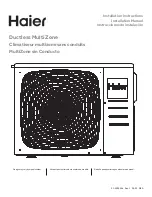
13
Laboratory Exhaust Systems
®
Start-Up
Visual Inspection of Equipment
The equipment type and arrangement should be verified
as ordered at once when it arrives at the jobsite. When
a discrepancy is found, the local sales representative
must be notified immediately so that corrective action
may be investigated, also verify electrical conformance
to specifications. Unauthorized alterations and
unauthorized backcharges will not be recognized by the
manufacturer.
After the unit has been assembled, installed and all
utilities have been hooked up, the unit is now ready for
operation.
Check
Before starting the unit, check the following:
1. Confirm that building supply voltage matches the
voltage for which the unit is wired.
2. Check all piping and wiring penetrations made by
contractors for water tightness. All penetrations
must be made watertight to prevent water damage
to the unit and building.
3. Rotate the fan wheel manually to be sure that it is
free to operate. Remove any dirt or debris that may
have accumulated during installation.
4. Check the fan bearing setscrews for tightness.
5. Check alignment of sheaves and V-belts (see
maintenance section).
6. Inspect all fasteners to ensure that none have
loosened during shipment.
7. Check flex coupling for proper alignment and
connect between motor shaft and fan shaft (direct
drive).
8. Check all guarding to ensure that it is securely
attached and not interfering with rotating parts.
9. Check operation of isolation and bypass dampers (if
supplied) for freedom of movement.
10. Check all electrical connections for proper
attachment.
11. Check housing and ductwork, if accessible, for
obstructions and foreign material that may damage
the fan wheel.
12. Fill drainage piping trap.
WARNING
Disconnect and secure to the
OFF
position all
electrical power to the fan prior to inspection or
servicing. Failure to comply with this safety precaution
could result in serious injury or death.
Additional steps for initial start-up
1. Check for proper wheel rotation by
momentarily energizing the fan.
Access to view the wheel can
be gained through the blower
housing access panel located
on the side of the fan’s tubular
housing.
One of the most frequently
encountered problems
are motors that are wired
to rotate the wheel in the
wrong direction. This is
especially true with 3-phase
installations where the motor will run in either
direction, depending on how it has been wired. To
reverse rotation of a 3-phase motor, interchange any
two of the three electrical leads. Single phase motors
can be reversed by changing internal connections as
described on the motor label or wiring diagram.
2. Fans with multi-speed motors should be checked on
low speed during initial start-up.
3. Check for unusual noise, vibration or overheating of
bearings. Refer to the “Troubleshooting” section of
this manual if a problem develops.
4. Grease may be forced out of the bearing seals during
initial start-up. This is a normal self-purging feature
for the type of bearing used on this product.
Blower Housing
Access Panel
Direction of
wheel rotation
Airflow






































